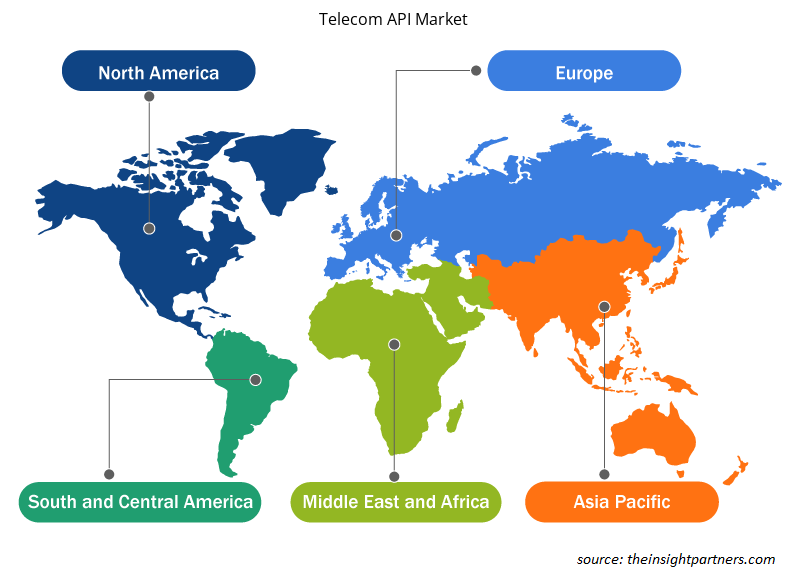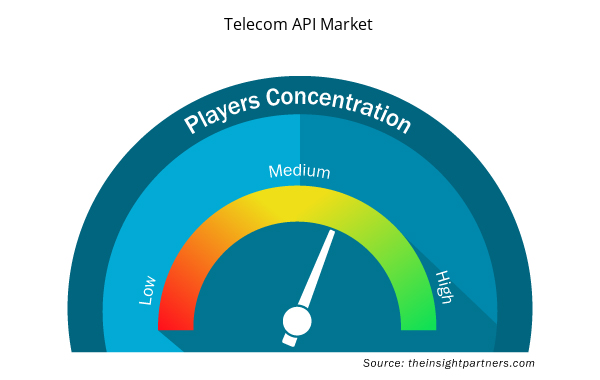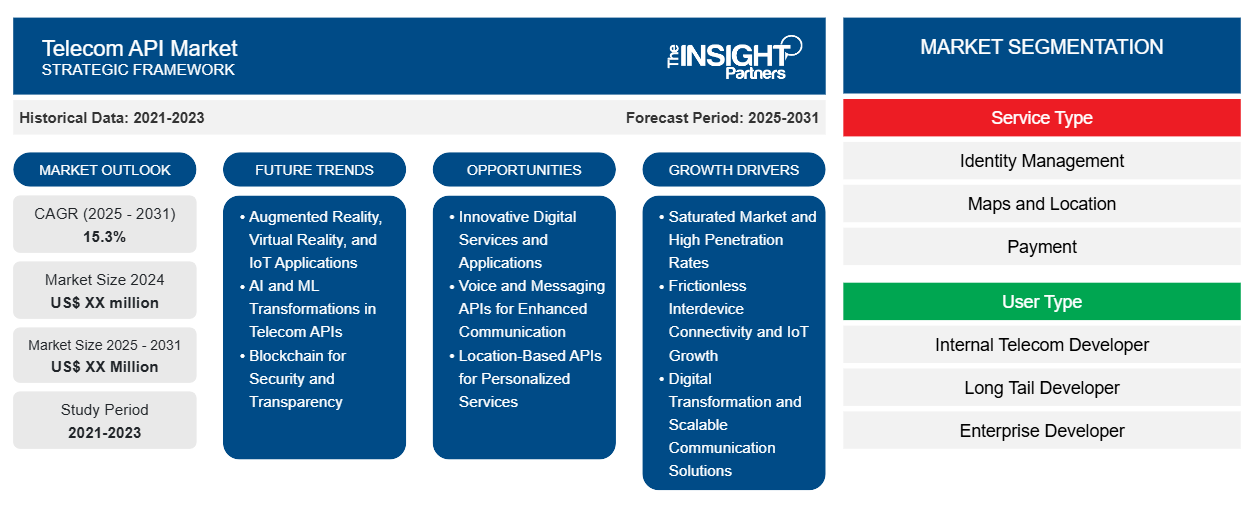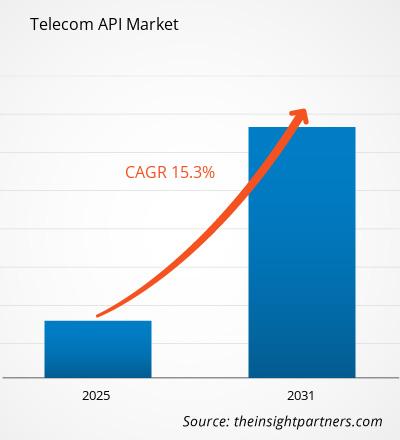Se espera que el mercado de API de telecomunicaciones registre una CAGR del 15,3 % entre 2023 y 2031, con un tamaño de mercado que se expandirá de US$ XX millones en 2023 a US$ XX millones en 2031.
El informe de investigación de mercado de API de telecomunicaciones está segmentado por tipo de servicio en los siguientes subsegmentos: gestión de identidad, mapas y ubicación, pagos, voz/voz, WebRTC, SMS, MMS y RCS. El informe proporciona además un análisis basado en el tipo de usuario, es decir, desarrollador interno de telecomunicaciones, desarrollador de cola larga, desarrollador empresarial y desarrollador asociado. El análisis global se desglosa a nivel regional y por países principales. La evaluación del mercado se presenta en dólares estadounidenses para el análisis segmentario anterior.
Propósito del Informe
El informe Telecom API Market de The Insight Partners tiene como objetivo describir el panorama actual y el crecimiento futuro, los principales factores impulsores, los desafíos y las oportunidades. Esto proporcionará información a diversas partes interesadas del negocio, como:
- Proveedores/fabricantes de tecnología: Para comprender la dinámica cambiante del mercado y conocer las oportunidades potenciales de crecimiento, lo que les permitirá tomar decisiones estratégicas informadas.
- Inversionistas: Realizar un análisis exhaustivo de tendencias sobre la tasa de crecimiento del mercado, las proyecciones financieras del mercado y las oportunidades que existen en toda la cadena de valor.
- Órganos reguladores: Regular las políticas y vigilar las actividades del mercado con el objetivo de minimizar los abusos, preservar la confianza de los inversores y defender la integridad y la estabilidad del mercado.
Segmentación del mercado de API de telecomunicaciones
Tipo de servicio
- Gestión de identidad
- Mapas y ubicación
- Pago
- Voz/Discurso
- WebRTC
- Mensaje de texto
- MMS y RCS
Tipo de usuario
- Desarrollador interno de telecomunicaciones
- Desarrollador de cola larga
- Desarrollador empresarial
- Desarrollador asociado
Personalice este informe según sus necesidades
Obtendrá personalización en cualquier informe, sin cargo, incluidas partes de este informe o análisis a nivel de país, paquete de datos de Excel, así como también grandes ofertas y descuentos para empresas emergentes y universidades.
- Obtenga las principales tendencias clave del mercado de este informe.Esta muestra GRATUITA incluirá análisis de datos, desde tendencias del mercado hasta estimaciones y pronósticos.
Factores impulsores del crecimiento del mercado de API de telecomunicaciones
- Mercado saturado y altas tasas de penetración: los proveedores de API de telecomunicaciones se enfrentan a un mercado saturado con altas tasas de penetración de dispositivos móviles, lo que impulsa la demanda de soluciones digitales innovadoras y API de telecomunicaciones.
- Conectividad entre dispositivos sin inconvenientes y crecimiento de la IoT: la creciente demanda de conectividad entre dispositivos sin inconvenientes y el auge de la Internet de las cosas están acelerando la adopción de las API de telecomunicaciones.
- Transformación digital y soluciones de comunicación escalables: el crecimiento del mercado de API de telecomunicaciones está impulsado por la necesidad de las industrias de contar con soluciones de comunicación efectivas y escalables como parte de su transformación digital.Scalable Communication Solutions: The growth of the Telecom API market is fueled by industries’ need for effective, scalable communication solutions as part of their digital transformation.
Tendencias futuras del mercado de API de telecomunicaciones
- Realidad aumentada, realidad virtual y aplicaciones de IoT: las aplicaciones emergentes como la realidad aumentada, la realidad virtual y la Internet de las cosas impulsarán aún más el mercado de API de telecomunicaciones con servicios y soluciones innovadores.IoT Applications: Emerging applications like augmented reality, virtual reality, and the Internet of Things will further fuel the Telecom API market with innovative services and solutions.
- Transformaciones de IA y ML en las API de telecomunicaciones: la IA y el aprendizaje automático de próxima generación revolucionarán el mercado de las API de telecomunicaciones, permitiendo la automatización inteligente, el análisis predictivo y las experiencias personalizadas del cliente.
- Blockchain para seguridad y transparencia: las API de telecomunicaciones integrarán la tecnología Blockchain para mejorar la seguridad, la transparencia y la credibilidad en las transacciones digitales, impulsando la confianza del consumidor.
- Creciente demanda de soluciones de comunicación eficientes: la creciente demanda de soluciones de comunicación seguras, eficientes y sin complicaciones consolidará las API de telecomunicaciones como un componente clave de la conectividad digital.
Oportunidades de mercado de API de telecomunicaciones
- Servicios y aplicaciones digitales innovadores: las API de telecomunicaciones ofrecen oportunidades para que las empresas desarrollen servicios y aplicaciones digitales innovadores que se alineen con los intereses de los clientes y al mismo tiempo optimicen los procesos.
- API de voz y mensajería para una comunicación mejorada: las API de voz y mensajería permiten la mensajería instantánea y otras oportunidades de comunicación, mejorando las interacciones con los clientes y la prestación de servicios.
- API basadas en la ubicación para servicios personalizados: las API de telecomunicaciones, como las API basadas en la ubicación, se pueden aprovechar para ofrecer servicios personalizados y mejorar las experiencias de los clientes.
Perspectivas regionales del mercado de API de telecomunicaciones
Los analistas de Insight Partners explicaron en detalle las tendencias y los factores regionales que influyen en el mercado de API de telecomunicaciones durante el período de pronóstico. Esta sección también analiza los segmentos y la geografía del mercado de API de telecomunicaciones en América del Norte, Europa, Asia Pacífico, Medio Oriente y África, y América del Sur y Central.

- Obtenga datos regionales específicos para el mercado de API de telecomunicaciones
Alcance del informe sobre el mercado de API de telecomunicaciones
| Atributo del informe | Detalles |
|---|---|
| Tamaño del mercado en 2023 | XX millones de dólares estadounidenses |
| Tamaño del mercado en 2031 | US$ XX millones |
| CAGR global (2023 - 2031) | 15,3% |
| Datos históricos | 2021-2022 |
| Período de pronóstico | 2024-2031 |
| Segmentos cubiertos | Por tipo de servicio
|
| Regiones y países cubiertos | América del norte
|
| Líderes del mercado y perfiles de empresas clave |
|
Densidad de actores del mercado de API de telecomunicaciones: comprensión de su impacto en la dinámica empresarial
El mercado de API de telecomunicaciones está creciendo rápidamente, impulsado por la creciente demanda de los usuarios finales debido a factores como la evolución de las preferencias de los consumidores, los avances tecnológicos y una mayor conciencia de los beneficios del producto. A medida que aumenta la demanda, las empresas amplían sus ofertas, innovan para satisfacer las necesidades de los consumidores y aprovechan las tendencias emergentes, lo que impulsa aún más el crecimiento del mercado.
La densidad de actores del mercado se refiere a la distribución de las empresas o firmas que operan dentro de un mercado o industria en particular. Indica cuántos competidores (actores del mercado) están presentes en un espacio de mercado determinado en relación con su tamaño o valor total de mercado.
Las principales empresas que operan en el mercado API de telecomunicaciones son:
- Aepona Ltda.
- Corporación Apigee
- AT y T Inc.
- Compañía de desarrollo de Hewlett-Packard.
- Compañía: Huawei Technologies Co. Ltd.
Descargo de responsabilidad : Las empresas enumeradas anteriormente no están clasificadas en ningún orden particular.

- Obtenga una descripción general de los principales actores clave del mercado de API de telecomunicaciones
Puntos de venta clave
- Cobertura integral: el informe cubre de manera integral el análisis de productos, servicios, tipos y usuarios finales del mercado de API de telecomunicaciones, proporcionando un panorama holístico.
- Análisis de expertos: el informe se compila sobre la base de un profundo conocimiento de expertos y analistas de la industria.
- Información actualizada: El informe asegura relevancia comercial debido a su cobertura de información reciente y tendencias de datos.
- Opciones de personalización: este informe se puede personalizar para satisfacer los requisitos específicos del cliente y adaptarse adecuadamente a las estrategias comerciales.
Por lo tanto, el informe de investigación sobre el mercado de API de telecomunicaciones puede ayudar a abrir camino para descifrar y comprender el escenario de la industria y las perspectivas de crecimiento. Si bien puede haber algunas preocupaciones válidas, los beneficios generales de este informe tienden a superar las desventajas.
- Análisis histórico (2 años), año base, pronóstico (7 años) con CAGR
- Análisis PEST y FODA
- Tamaño del mercado Valor/volumen: global, regional, nacional
- Industria y panorama competitivo
- Conjunto de datos de Excel



Report Coverage
Revenue forecast, Company Analysis, Industry landscape, Growth factors, and Trends

Segment Covered
This text is related
to segments covered.

Regional Scope
North America, Europe, Asia Pacific, Middle East & Africa, South & Central America

Country Scope
This text is related
to country scope.
Preguntas frecuentes
The report can be delivered in PDF/PPT format; we can also share excel dataset based on the request.
Some of the customization options available based on request are additional 3-5 company profiles and country-specific analysis of 3-5 countries of your choice. Customizations are to be requested/discussed before making final order confirmation, as our team would review the same and check the feasibility.
The leading players of the market are: Aepona Ltd., Apigee Corp, AT and T Inc., Hewlett-Packard Development Co., Huawei Technologies Co. Ltd., Nexmo, Inc., Oracle Corporation, Orange S.A., Twilio, Inc., ZTE Soft Technology Co. Ltd.
The Telecom API market is looking at a far more promising future where it would see tremendous growth in innovations. With advancements in the adoption of 5G, the market for Telecom APIs will unlock new possibilities for faster data transfer speeds, lower latency, and greater connectivity. In addition, artificial intelligence and machine learning will transform the Telecom API market through intelligent automation, predictive analytics, and personalized customer experiences. This will increase the demand for the same overtime, because of IoT revolution, seamless connectivity of variety of devices and explicit need for scalable and efficient telecom APIs.
Telecom API Market is expected to grow at a CAGR of 15.3% between 2023-2031
The increasing demand for seamless, efficient communication solutions primarily drives the Telecom API market. Proliferation of mobile devices, Internet of Things, adoption of cloud-based services, and emphasis on digital transformation are some of the important factors driving this growth. Other factors driving up the adoption of Telecom APIs across industry boundaries include innovative digital services, personalized customer experiences, and real-time data analytics.
Trends and growth analysis reports related to Technology, Media and Telecommunications : READ MORE..
1. Aepona Ltd.
2. Apigee Corp
3. AT and T Inc.
4. Hewlett-Packard Development Co.
5. Huawei Technologies Co. Ltd.
6. Nexmo, Inc.
7. Oracle Corporation
8. Orange S.A.
9. Twilio, Inc.
10. ZTE Soft Technology Co. Ltd.
The Insight Partners performs research in 4 major stages: Data Collection & Secondary Research, Primary Research, Data Analysis and Data Triangulation & Final Review.
- Data Collection and Secondary Research:
As a market research and consulting firm operating from a decade, we have published and advised several client across the globe. First step for any study will start with an assessment of currently available data and insights from existing reports. Further, historical and current market information is collected from Investor Presentations, Annual Reports, SEC Filings, etc., and other information related to company’s performance and market positioning are gathered from Paid Databases (Factiva, Hoovers, and Reuters) and various other publications available in public domain.
Several associations trade associates, technical forums, institutes, societies and organization are accessed to gain technical as well as market related insights through their publications such as research papers, blogs and press releases related to the studies are referred to get cues about the market. Further, white papers, journals, magazines, and other news articles published in last 3 years are scrutinized and analyzed to understand the current market trends.
- Primary Research:
The primarily interview analysis comprise of data obtained from industry participants interview and answers to survey questions gathered by in-house primary team.
For primary research, interviews are conducted with industry experts/CEOs/Marketing Managers/VPs/Subject Matter Experts from both demand and supply side to get a 360-degree view of the market. The primary team conducts several interviews based on the complexity of the markets to understand the various market trends and dynamics which makes research more credible and precise.
A typical research interview fulfils the following functions:
- Provides first-hand information on the market size, market trends, growth trends, competitive landscape, and outlook
- Validates and strengthens in-house secondary research findings
- Develops the analysis team’s expertise and market understanding
Primary research involves email interactions and telephone interviews for each market, category, segment, and sub-segment across geographies. The participants who typically take part in such a process include, but are not limited to:
- Industry participants: VPs, business development managers, market intelligence managers and national sales managers
- Outside experts: Valuation experts, research analysts and key opinion leaders specializing in the electronics and semiconductor industry.
Below is the breakup of our primary respondents by company, designation, and region:

Once we receive the confirmation from primary research sources or primary respondents, we finalize the base year market estimation and forecast the data as per the macroeconomic and microeconomic factors assessed during data collection.
- Data Analysis:
Once data is validated through both secondary as well as primary respondents, we finalize the market estimations by hypothesis formulation and factor analysis at regional and country level.
- Macro-Economic Factor Analysis:
We analyse macroeconomic indicators such the gross domestic product (GDP), increase in the demand for goods and services across industries, technological advancement, regional economic growth, governmental policies, the influence of COVID-19, PEST analysis, and other aspects. This analysis aids in setting benchmarks for various nations/regions and approximating market splits. Additionally, the general trend of the aforementioned components aid in determining the market's development possibilities.
- Country Level Data:
Various factors that are especially aligned to the country are taken into account to determine the market size for a certain area and country, including the presence of vendors, such as headquarters and offices, the country's GDP, demand patterns, and industry growth. To comprehend the market dynamics for the nation, a number of growth variables, inhibitors, application areas, and current market trends are researched. The aforementioned elements aid in determining the country's overall market's growth potential.
- Company Profile:
The “Table of Contents” is formulated by listing and analyzing more than 25 - 30 companies operating in the market ecosystem across geographies. However, we profile only 10 companies as a standard practice in our syndicate reports. These 10 companies comprise leading, emerging, and regional players. Nonetheless, our analysis is not restricted to the 10 listed companies, we also analyze other companies present in the market to develop a holistic view and understand the prevailing trends. The “Company Profiles” section in the report covers key facts, business description, products & services, financial information, SWOT analysis, and key developments. The financial information presented is extracted from the annual reports and official documents of the publicly listed companies. Upon collecting the information for the sections of respective companies, we verify them via various primary sources and then compile the data in respective company profiles. The company level information helps us in deriving the base number as well as in forecasting the market size.
- Developing Base Number:
Aggregation of sales statistics (2020-2022) and macro-economic factor, and other secondary and primary research insights are utilized to arrive at base number and related market shares for 2022. The data gaps are identified in this step and relevant market data is analyzed, collected from paid primary interviews or databases. On finalizing the base year market size, forecasts are developed on the basis of macro-economic, industry and market growth factors and company level analysis.
- Data Triangulation and Final Review:
The market findings and base year market size calculations are validated from supply as well as demand side. Demand side validations are based on macro-economic factor analysis and benchmarks for respective regions and countries. In case of supply side validations, revenues of major companies are estimated (in case not available) based on industry benchmark, approximate number of employees, product portfolio, and primary interviews revenues are gathered. Further revenue from target product/service segment is assessed to avoid overshooting of market statistics. In case of heavy deviations between supply and demand side values, all thes steps are repeated to achieve synchronization.
We follow an iterative model, wherein we share our research findings with Subject Matter Experts (SME’s) and Key Opinion Leaders (KOLs) until consensus view of the market is not formulated – this model negates any drastic deviation in the opinions of experts. Only validated and universally acceptable research findings are quoted in our reports.
We have important check points that we use to validate our research findings – which we call – data triangulation, where we validate the information, we generate from secondary sources with primary interviews and then we re-validate with our internal data bases and Subject matter experts. This comprehensive model enables us to deliver high quality, reliable data in shortest possible time.


 Obtenga una muestra gratuita de este informe
Obtenga una muestra gratuita de este informe